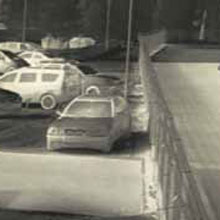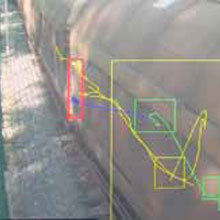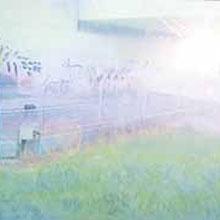 |
| FLIR thermal imaging cameras secure the perimetre of Industriepark Höchst |
Within the premises of Industriepark Höchst there are over 800 rental properties, 120 production plants and over 80 laboratory and office buildings that accommodate the in total 22,000 employees that work there. The compound stretches over 460 hectares of which 50 are still available for relocating or expanding companies. There are three means of transportation in and out of the park: by car, by train and by boat.
Security: a major priority
Given the importance and in some cases sensitivity of the chemical and pharmaceutical production facilities and related process industries located at Industriepark Höchst, security is a major priority. Securing such a large area with so many access paths isn't an easy task. As the service company of the industrial park, it is Infraserv Höchst that has the responsibility to make sure the park is safe and secure. Infraserv supplies the companies that inhabit the industrial park with energy, disposes of waste, and provides access to business space and infrastructure. Its service portfolio ranges from environmental, security and safety services all the way to health products, communications and IT. To be able to effectively secure the entire perimetre of this large industrial complex, even during the night, Infraserv uses thermal imaging cameras from FLIR.
"We have installed security cameras of several different types to cover the entire perimetre of the industrial park, including several thermal imaging cameras", explains Thomas Krüger, head of the control centre at Infraserv. "The thermal imaging cameras we use are the FLIR SR-313 with a 35 mm lens and the FLIR SR-324 with a 19 mm lens. We chose these cameras because they were an effective and affordable solution for the challenges that we had to face with securing this dynamic industrial park."
Perfect night vision
Thermal imaging cameras provide perfect night vision in even the darkest of nights. Intruders show up very clearly in a crisp thermal image due to the contrast in temperature between a person and his surroundings. But that's not all; thermal imaging cameras can also see through obscurants like smoke, dust, foliage and fog better than a CCTV camera.
Krüger is very happy with his FLIR thermal imaging cameras. "Sometimes I wish that I had this technology at my disposal when we started installing our security network. I probably would have installed many more thermal imaging cameras than we have now, for in most situations they're much better than CCTV cameras."
Krüger purchased the FLIR thermal imaging cameras from FLIR products distributer VIDEOR. As one of the leading European distributors of professional video technology VIDEOR has a market experience of over thirty years. The wide product range of the near Frankfurt based company covers components and integrated systems in the security, networking, imaging and broadcast sectors, based on strict quality standards.
Bird's eye view
Due to his positive experience with thermal imaging, Krüger is now contemplating to install a new thermal imaging camera in a high location. The best solution for such a location is probably the FLIR PTZ-35x140 MS thermal imaging camera. With its two thermal imaging cameras and one low light camera it provides perfect vision, even in total darkness. The two thermal imaging cameras provide a continuous optical zoom, with a wide-angle thermal imager for situational awareness and a narrow field-of-view imager that has been designed for mid-range target recognition.
If Krüger would choose to opt for the FLIR PTZ-35x140 MS, it would be able to utilize its long range performance to its full potential from its high vantage point and with its full 360° viewing capability it would be able to observe the entire park. "That would be quite useful", explains Krüger. "Not only could we use that to spot intruders, we could also put it to good use in case of fire or spillage, monitoring and directing the firefighting or salvage operation."
 |
| FLIR SR- series cameras provide excellent nightime vision even in complete darkness |
No lights needed
The thermal imaging cameras that are already operational have proved their use. "We've put them in locations where it's difficult for CCTV cameras to be effective", explains Krüger. "In certain areas it is difficult due to the infrastructure to put up proper lighting, for instance. With a thermal imaging camera you don't need lights."
Thermal imaging cameras are incredibly useful to see at night, but according to Krüger that's not their only advantage. "Both the FLIR SR-313 and the FLIR SR-324 have an excellent range performance." Depending on the conditions these two thermal imaging cameras can detect trespassers at a range of up to respectively 450 and 780 meters.
Better range with thermal imaging cameras
Thermal imaging cameras in general have a better range performance than CCTV cameras, explains Krüger. "With a CCTV camera you have to depend on visual contrast to be able to see a person that's trespassing, but that can be quite difficult, especially when lighting conditions aren't perfect, such as on a cloudy day for instance. The contrast on a thermal image is much bigger, due to the difference in temperature and thermal radiation between a person and his surroundings. Due to that fact you can detect a person with a thermal imaging camera at a larger distance than with a CCTV camera. And because you can see farther with one camera, you need fewer cameras to cover the same area."
‘Very good return on investment'
According to Krüger this makes thermal imaging cameras very cost-effective. "Not only because you need fewer cameras. Installing a complete security solution involves a lot more than just the camera itself. There's an entire infrastructure you have to take into account. For every camera you install you need a power supply line, a mast for the camera to be mounted on and with a CCTV camera you also have to install several streetlights to make it effective at night. A thermal imaging camera needs only one mast and no lighting. The total cost of ownership for a thermal imaging camera is extremely low so even though the price of one thermal imaging camera is higher, in the end it is cheaper to install a thermal imaging camera than to install several CCTV cameras. In my opinion thermal imaging cameras really offer a very good return on investment."
Monitoring inaccessible areas
The better range of a thermal imaging camera isn't just important for cost-effectiveness explains Krüger: "Due to the longer range you can use thermal cameras to monitor inaccessible areas that are difficult to cover with CCTV cameras. Here at Infraserv Höchst we have the problem that some parts of the perimetre we monitor are under constant danger of flooding, because we're located on the banks of the river Main. That situation makes it very challenging to secure those areas. Ground sensors or fences are not an option due to the floods and CCTV cameras combined with lighting also proved to be an ineffective solution, for the floods would damage the power supply of both cameras and the lights. But with thermal imaging cameras we can put a camera outside the flood-threatened area, looking in, and thus secure that entire area without risking flood-related damage."
 |
| FLIR SR-series pick up the unauthorized movement [red brackets] but do not indicate an unwanted alarm |
Fewer unwanted alarms with thermal imaging cameras
In Krüger's experience, there is also a significant difference between thermal imaging cameras and CCTV cameras in the amount of unwanted alarms. "We have about one unwanted alarm a week with our CCTV cameras. With our thermal imaging cameras we have about one a year, if we have any at all."
"Our video-analysis software, Aimetis Symphony, uses complicated Algorithms to detect and analyse movement", explains Krüger. "The software then compares the perceived movement to previously defined parametres and if the movement is not within those parametres, an alarm goes off. But not every unauthorized movement is a trespasser. The cause of such unwanted alarms can be a spider crawling across the camera's lens, braches of a tree moving in the wind or even graffiti on a moving train."
Thermal imaging cameras trigger fewer unwanted alarms, according to Krüger. "The difference between thermal imaging cameras and CCTV cameras is the contrast. CCTV cameras rely on visual contrast where thermal imaging cameras rely on thermal contrast and that difference is very important, because the thermal contrast is much bigger than the visual contrast. The branch of a tree moving in the winds does not show up as distinctly in the thermal image as a person does. That means that it is easier for the video-analysis software to separate actual intruders from other types of movement on footage from a thermal imaging camera. This reduces the amount of unwanted alarms and that in turn saves us a lot of time and money."
Spider webs and sun glare 
Sunlight reflects on a spider web in front of the lens and blinds CCTV camera.
The unwanted alarm problem isn't the only issue where thermal imaging cameras defeat CCTV cameras, even during the day: there's also the issue of sun-glare. "When the sun shines directly into the lens of a CCTV camera it is rendered completely useless", explains Krüger. But this problem doesn't just occur with the sun directly shining into the lens, it can also shine into the lens indirectly due to reflection. According to Krüger this happens quite often with spider webs. "Sometimes there's a piece of spider web in front of the camera that's so small that you hardly even notice it. But when the sunlight hits the web in a certain angle it is reflected into the lens, blinding the CCTV camera exactly like when the sun shines directly on it. In such cases one of our staff must go and remove the spider web if we want to be able to use the camera effectively."
Identifying trespassers
According to Krüger thermal imaging cameras are superior to CCTV cameras on all fronts. "In fact, the only reason I still use CCTV cameras is that they can be more effectively used to identify trespassers. That's important information, because we can better assess the situation if we know what type of intruder we're dealing with and if we decide to prosecute the trespasser we give the footage to the police. If we could use the thermal imaging cameras to do that then normal CCTV cameras would be obsolete."
















